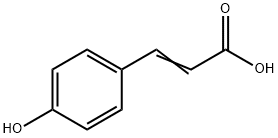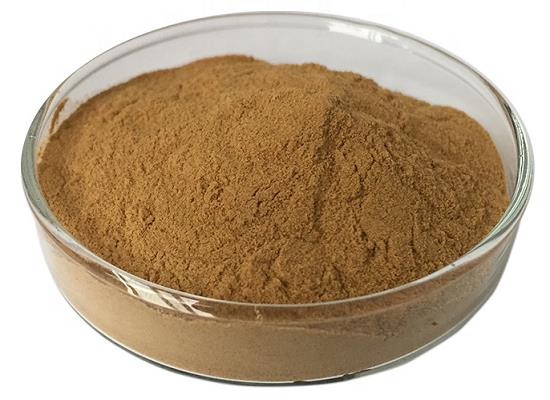4-Hydroxycinnamic Acid: Dietary Sources, Pharmacokinetics and Biological Activities
General Description
4-Hydroxycinnamic acid is a plant-derived phenolic compound found in various dietary sources, particularly mushrooms, grains, fruits, and vegetables. 4-Hydroxycinnamic acid exhibits high bioavailability, rapidly absorbed in the gastrointestinal tract, with a significant portion remaining in circulation for extended periods. It possesses strong antioxidant and antimicrobial properties, effectively scavenging free radicals and enhancing wound healing. Additionally, 4-Hydroxycinnamic acid has anti-inflammatory effects, reducing pro-inflammatory markers and hepatotoxicity, while also showing promising anticancer potential by inhibiting cancer cell proliferation. These biological activities highlight its potential benefits in health and nutrition, making it a valuable functional compound.

Figure 1. 4-Hydroxycinnamic acid
Dietary Sources
4-Hydroxycinnamic acid occurs naturally in various dietary sources, primarily within the plant kingdom. This compound is notably present in certain mushroom species, including Ganoderma lucidum and Cantharellus cibarius, where levels can reach several milligrams per gram, significantly higher than in most fruits. In addition to mushrooms, 4-Hydroxycinnamic acid can be found in grains, vegetables, and fruits, although its concentration varies widely among different sources. This compound exists both in free and bound forms; bound 4-Hydroxycinnamic acid is usually conjugated with other molecules, improving its solubility and bioactivity. For instance, the water-soluble portion of bound 4-Hydroxycinnamic acid can be linked to sugars and organic acids, displaying enhanced biological properties. Conversely, water-insoluble forms of 4-Hydroxycinnamic acid are often associated with lignocellulosic materials, which can contribute to dietary fiber intake. Understanding the dietary occurrence of 4-Hydroxycinnamic acid can inform nutritional studies and health benefits associated with plant-based foods. 1
Pharmacokinetics
Bioavailability
4-Hydroxycinnamic acid exhibits notable pharmacokinetic properties that underscore its bioavailability compared to other phenolic acids. Research has demonstrated that 4-Hydroxycinnamic acid has higher bioavailability than compounds such as chlorogenic acid, rosmarinic acid, caffeic acid, and ferulic acid. It can be absorbed throughout the gastrointestinal tract, particularly in the jejunum, which shows the highest absorption rates. The bioavailability of this compound is often assessed by measuring its concentrations in plasma and urine following ingestion. Studies indicate that the time to reach maximum plasma concentration for 4-Hydroxycinnamic acid after oral administration is notably rapid, with values as low as 3.72 minutes. This speed is contrasted with the absorption rates of other phenolic acids, notably ferulic acid, which takes longer to reach peak concentrations. 1
Metabolism and Excretion
Upon absorption, 4-Hydroxycinnamic acid remains predominantly in its free form, with over half of the absorbed amount persisting in circulation even after 60 minutes. This characteristic highlights its stability and prolonged presence in the bloodstream compared to ferulic acid, which diminishes rapidly. Furthermore, while some of the absorbed 4-Hydroxycinnamic acid undergoes conjugation in the liver—primarily with glucuronides and sulfates—most remains in its unbound state. The urinary excretion rate of free 4-Hydroxycinnamic acid is significantly higher than that of ferulic acid, indicating an efficient elimination process. With 24% of free 4-Hydroxycinnamic acid appearing in rat urine, this suggests a favorable metabolic pathway that enhances its potential health benefits and bioactive properties in humans. The distinct pharmacokinetic profile of 4-Hydroxycinnamic acid emphasizes its significance within dietary sources and its probable utility in health-related applications. 1
Biological Activities
Antioxidant and Antimicrobial Activities
4-Hydroxycinnamic acid, a notable phenolic compound found abundantly in various fruits, vegetables, and cereals, displays significant antioxidant properties that contribute to its health benefits. Acting as a potent scavenger of reactive oxygen species and free radicals, 4-Hydroxycinnamic acid has demonstrated its protective effects in various in vitro studies, including cultured endothelial cells exposed to high glucose and lens epithelial cells treated with hydrogen peroxide. Its ability to reduce oxidative stress can help prevent chronic diseases linked to oxidative damage. Moreover, 4-Hydroxycinnamic acid exhibits antimicrobial activity by disrupting bacterial cell membranes, which enhances its potential use in skincare formulations aimed at wound healing. Polymeric preparations containing this compound not only exhibit antioxidant effects but also support skin regeneration, underscoring the versatility of 4-Hydroxycinnamic acid in promoting health. 2
Anti-Inflammatory and Anticancer Effects
In addition to its antioxidant and antimicrobial properties, 4-Hydroxycinnamic acid also demonstrates robust anti-inflammatory effects in various models. Studies have indicated that this compound reduces levels of pro-inflammatory markers, such as tumor necrosis factor-alpha, thereby mitigating inflammation in conditions such as arthritis. Furthermore, it has shown potential in reducing hepatotoxicity caused by substances like alcohol and acetaminophen while alleviating pulmonary inflammation from environmental stressors. Importantly, research suggests that 4-Hydroxycinnamic acid may have promising anticancer properties; it inhibits the proliferation and migration of cancer cells and promotes their apoptotic death. Its chemopreventive effects against colon cancer have been confirmed in animal studies, where it not only reduced inflammatory responses but also enhanced antioxidant defenses. These diverse biological activities emphasize the potential of 4-Hydroxycinnamic acid as a functional compound in both therapeutic and preventive health strategies. 2
References:
[1] K. PEI. p-Coumaric acid and its conjugates: dietary sources, pharmacokinetic properties and biological activities.[J]. Journal of the Science of Food and Agriculture, 2016, 1 1: 65-69. DOI:10.1002/jsfa.7578.[2] BOO Y C. p-Coumaric Acid as An Active Ingredient in Cosmetics: A Review Focusing on its Antimelanogenic Effects.[J]. Antioxidants, 2019, 8 8. DOI:10.3390/antiox8080275.
You may like
See also
Lastest Price from 4-Hydroxycinnamic acid manufacturers

US $0.00-0.00/kg2025-07-18
- CAS:
- 7400-08-0
- Min. Order:
- 1kg
- Purity:
- 99%
- Supply Ability:
- 1000kg

US $10.00/KG2025-04-21
- CAS:
- 7400-08-0
- Min. Order:
- 1KG
- Purity:
- 99%
- Supply Ability:
- 10 mt


